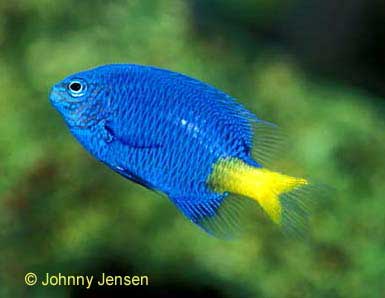|
|
Yellowtail Damselfish

The Yellowtail Damsel is also known as the Yellowtail Blue Damselfish, the Yellowtail Demoiselle and the Goldtail Demoiselle. It is confused in naming with the Azure Damselfish (Chrysiptera hemicyanea), which is yellow in the pectoral and anal fins, but not in the tail. The Yellowtail comes from the central and western Pacific, including the Red Sea. It is bright
blue, with a yellow tail that fades to clear at the edges.

Yellowtail Damsels are very popular and are a good beginne's fish. They eat a wide range
of foods, withstand poor water conditions, are disease resistant and they are inexpensive.
They are often used as the first fish introduced to a new tank. A tank of at least 100 gallons
is recommended, but it is possible to keep a single Yellowtail in a smaller tank if there aren't
many other inhabitants. Although Yellowtails are among the least aggressive damsels, they still
should be provided with plenty of hiding places and kept either alone or in groups of 4 or 5 in
a large tank to reduce aggression.
The Yellowtail is an omnivore. It will eat vegetable matter, spirulina, flake foods and mysis
shrimp. The Yellowtail is also reef safe, as it will ignore invertebrates and feed on zooplankton
and algae. Feedings should be made in small amounts several times per day.

The Yellowtail has been bred in captivity. Males are usually larger and more slender. When
ready to breed, the male becomes very aggressive toward the females and the mating ritual usually
occurs in the early morning. An open clam shell is a good location for depositing the hundreds of
adhesive eggs. The male is responsible for cleaning the area and guarding the eggs. It does so
vigorously against all intruders. The fry hatch in about a week. They are very small and will be
sucked in to running filters, so a tank where these can be shut off is necessary. The fry should be
raised on rotifers (produced in the green water of rotting vegetables). The use of brine shrimp during
the first month is not recommended. Within a month, the fry will take on the blue coloring, including
the yellow tail. Yellowtails can live more than 5 years in an aquarium.
| Scientific Name: |
Chrysiptera parasema |
| Family: |
Pomacentridae |
| Care: |
Easy |
| Temperature: |
23 - 29 C; 74 - 84 F |
| pH: |
8.0 - 8.4 |
| dH: |
8 - 12 |
| Specific Gravity: |
1.020 - 1.030 |
| Size: |
8 cm; 3 inches |
| Breeding: |
Egg Layer |
| Life Span: |
5 years |
| Crustacean Safe: |
Yes |
| Coral Safe: |
Yes |
|
Compatibility:
|
|
Suitable tank mates include small Angels, Blennies,
Rabbitfish, Yellow Tang.
|
|